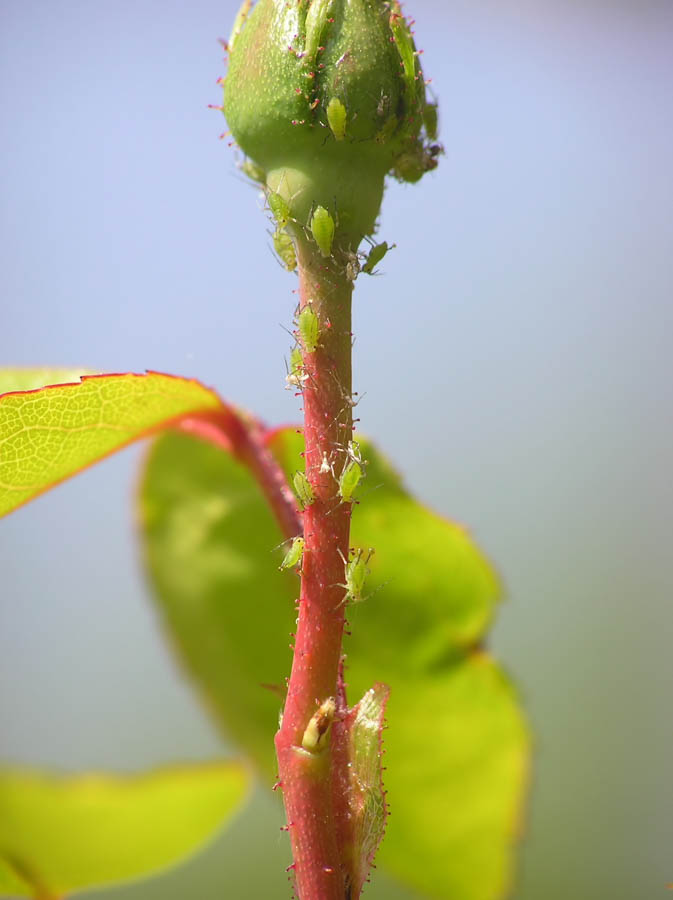Aphids: Minimize Populations Using Organic Controls

GardenZeus earns commissions on sales made through links in this article. There is no additional cost to you.
Aphids are soft-bodied sucking insects that feed by sucking the sap of host plants, damaging plant leaves and soft stems. They may even limit plants’ ability to transport nutrients through damaged plant tissue. Aphids feed on an enormous array of plant species from fruits and vegetables to ornamental plants. There are more than 100 species of aphids, in a variety of colors, including green, brown grey and yellow. Most aphids do not grow to be larger than ¼ inch in size, making them difficult to see individually.
Symptoms of aphid damage include: yellowing and curling leaves, dead brown areas on leaves and stems, stunted growth, deformed fruits, sticky honeydew exudates on leaves, and sooty mold. Aphids may also transmit pathogens that can harm or kill plants.
The good news: low to moderate numbers of aphids are unlikely to cause significant damage to most plants and trees.
GardenZeus-recommended steps to minimize aphid populations:
- Aphids feed on the lush, new green growth of spring. Don’t over-fertilize with nitrogen. If you use fertilizer, use organic or slow-release fertilizers.
- Expect aphid populations to rise in the spring and during periods of warm-to-hot weather. Aphids in small numbers won’t seriously damage most plants.
- Control ants to help beneficial insects and natural enemies control aphids. Ants protect aphids from their natural enemies. Keep ants off your plants so the beneficials and natural enemies can work, including lady beetles, lacewings, and parasitic wasps.
- Wait for hot summer weather. Many aphids can’t tolerate extended periods of heat and may be gone or populations may naturally diminish in hot areas by the middle of summer.
Nontoxic direct-control options to consider:
- Squash or remove aphids manually with a thinly gloved finger. This works best with early infestations and on smaller, robust plants. In some cases it may be possible to remove aphids by shaking the plant.
- For early infestations and mild-to-moderate populations, consider spraying infested plant areas directly with a strong stream of water from your garden hose.
As populations rise to the point of infestation, consider spraying your plants with a solution of diluted, nontoxic, biodegradable soap and water. Mix about 1 Tablespoon of soap to 1 quart of water, put the solution into a clean garden spray bottle and take aim.
Select your soap carefully. Use pure Castile soap or other similar pure soap made of animal fats or vegetable oils. Most brands of dish soap contain fragrance, hand softeners, antibacterial agents and degreasers, any of which can harm your plants. Do not use anything labeled as “detergent.” Detergents will not contain the animal fats or vegetables oils necessary to smother the aphids.
Start with a test to be sure that your soap solution won’t harm your plants. Spray the undersides of a few leaves with the solution and wait at least 24-to-48 hours to make sure your plant tolerates the solution. Never spray a plant that is stressed such as from lack of water or extreme heat.
Spray your plants either early in the morning or early evening when the weather is relatively cool and the soap solution will stay on the plants longer. The longer the soap solution remains on the plants, the more effective it will be. Apply thoroughly. Take care to saturate the underside of the leaves where aphids tend to hide.
Repeat after a few days to a week. You may have to apply the soap solution several times or increase the proportion of soap in your solution to control aphid populations.
The advantage of using a soap solution? It may control aphid populations without the use of insecticides that are toxic to beneficial insects and natural enemies of aphids, which may be toxic to people and animals, and which may cause other environmental harm.
Additional tip: some gardeners like to add a small amount of cayenne pepper to the soap and water solution to deter insects and mammalian pests that like to chew on plants. Avoid using cayenne pepper anytime there might be exposure to pets, other animals, and people, especially children.
GardenZeus has customized gardening information by plant and zip code. To get started, enter your zip code here.
Other articles of interest on warm season pests and diseases:
Tomato and Tobacco Hornworms in the California Home Garden
Yellow Leaves on Tomato Plants: A GardenZeus Guide, Part 3 of 3
